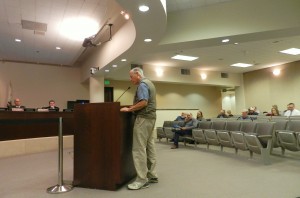
“Sustainability is the 21st century IQ test,” said Brad Barker, “and you can’t keep postponing your way to sustainability.”
Barker, Conservation Chair for Yokuts Sierra Club, was speaking at last Tuesday’s meeting of the Stanislaus County Board of Supervisors. The agenda item concerned approval of a newly-revised groundwater ordinance.
Barker was one among many who thought the supervisors had waited too long to regulate pumping groundwater on the county’s east side where tens of thousands of acres of almond orchards have covered former rangeland with no access to surface water.
One of the more controversial elements of the ordinance requires anyone outside an irrigation district who wants to drill a large well to “prove” sustainability.
“There’s no way we can calculate what the sustainability is,” said Sean Roddy, a well-driller who operates Hennings Bros. Drilling Company in Modesto. “The strata we’re pumping are hydrologically and geologically different.”
Roddy and others believe there’s not yet enough reliable data to justify regulations for pumping groundwater. He’s also among a dwindling minority who think the groundwater crisis has been over-hyped.
“The sky is not falling,” he said. “There’s a cyclical constant. Some areas do show sustainability.”
The sky may not be falling, but the water table is, and not just in Stanislaus County. Satellite data show severely overdrafted basins from the Ogallala Aquifer, to the Colorado River Basin, through most of the San Joaquin Valley. And even though it has rivers on three sides and one of the Valley’s last thick and saturated aquifers on its east side, Stanislaus County is poised to join others who’ve managed to deplete what once were thought of as inexhaustible water supplies.
Stanislaus Audubon Society President Sal Salerno joined a growing number of citizens concerned not only about overdrafting groundwater but also about the loss of rangeland.
“Someone recently characterized the overdrafting of groundwater by corporate almond growers as akin to agricultural strip mining, and we fear that is an accurate analogy,” he said. “The diminishing groundwater belongs to all of the people, not only for large corporations that have the wealth to drill the deepest and largest wells.”
“The conversion of rangelands by permanent crops is not only a critical issue for people, but also for wildlife. Our grasslands support California’s most abundant populations of wintering hawks, falcons and eagles from the Arctic tundra, as well as such year-round species as Tricolored Blackbirds and Burrowing Owls. People are not the only inhabitants of the planet. Wildlife has an intrinsic right to exist, but people need to speak up for and protect that right.”
Before approving the ordinance, every Stanislaus County Supervisor acknowledged the severity of the situation. Supervisor Terry Withrow likened the groundwater crisis to critical care:
“I look at the first version of the ordinance as stabilizing the patient,” he said. “The ultimate goal is to cure the patient.”
Curing “the patient” will take more resolve than has been shown in other regions when authorities were faced with the responsibility of shutting down pumps. The one inescapable fact about groundwater that virtually no one wants to face was expressed by Supervisor Jim DeMartini just before all five supervisors voted in favor of the new ordinance:
“You can’t have thirty thousand acres of rangeland converted to permanent crops and not have an impact on groundwater,” he said. “It’s a finite supply.”
Today, one of the most water-rich counties in the San Joaquin Valley is faced with the growing prospect of becoming as water-poor as counties farther south, mostly because the “finite supply” is being exhausted at a pace no amount of rain or snowfall can replace.As long as the new ordinance does nothing to limit pumping for wells already in production, the “patient” isn’t really stabilized—hemorrhaging is ongoing and critical.

And HOW many new drilling permits have been submitted before last week’s deadline? What kind of situation will we be facing if all those permits are OKed and orchard owners are allowed to install wells, especially the large bore wells that pump such an ungodly amount of groundwater?
The public needs to insist on pumping data from all wells, and not anonymous data, either. If it is OK to use this much water, the orchard owners need to stop hiding their use. You only hide if you have something to hide, and you know that telling the truth will make many people unhappy.
My gratitude to Brad Barker, Sal Salerno and others who continue to speak up about water use in Stanislaus County. Remember when we used to rally around farmland preservation? This issue – unlimited pumping of our aquafer – is even more important. Let’s all work to keep Stanislaus County, and the entire San Joaquin Valley, from becoming a dust bowl and flat-lining our economy.